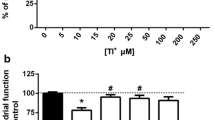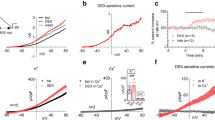Summary
Long term amiodarone (AM) therapy has been associated with several side effects including neurotoxicity. Since AM alters Ca2+ regulated events, we have studied its effects on the compartmentation of free Ca2+ in the synaptosomes as an attempt to understand the mechanism of AM and its metabolite, desethylamiodarone (DEA)-induced neurotoxicity. Intact brain synaptosomes were prepared from male Sprague-Dawley rats. Both AM and DEA produced a concentration dependent increase in intrasynaptosomal free Ca2+ concentration ([Ca2+]i) to micromolar levels. The increase in [Ca2+]i was not transient and a steady rise was observed with time. Omission of Ca2+ from the external medium prevented the AM- and DEA-induced rise in [Ca2+]i suggesting that AM and DEA increased the intracellular [Ca2+]i due to increased influx of Ca2+ from external medium. AM- and DEA-induced increase in intrasynaptosomal [Ca2+]i was neither inhibited by a calcium channel blocker, verapamil, nor with a Na+ channel blocker, tetrodotoxin. However, the blockade of [Ca2+]i rise by AM and DEA was observed with MK-801, a receptor antagonist indicating that AM and DEA induced rise in [Ca2+]i is through receptor mediated channel. Both AM and DEA also inhibited N-methyl-D-aspartic acid (NMDA)-receptor binding in synaptic membranes in a concentration dependent manner, DEA being more effective, indicating that AM and DEA compete for the same site as that of NMDA and confirm the observation that these drugs increase intrasynaptosomal [Ca2+]i through receptor mediated channel. 45Ca accumulation into brain microsomes and mitochondria was significantly inhibited by AM and DEA, but without any effect on the Ca2+ release from these intracellular organelles. Also, both these drugs did not interfere with inositol 1,4,5-trisphosphate induced Ca2+ release from microsomes even at 10 μM concentration. These results clearly indicate that both AM and DEA increase intrasynaptosomal [Ca2+]i by an action on receptor mediated channel in plasma membrane, but not due to the release of Ca2+ from intracellular storage sites. This initial rise in [Ca2+]i, together with other changes in Ca2+ homeostasis, might be responsible for AM and DEA-induced neurotoxicity.
Similar content being viewed by others
References
Bagchi N, Brown TR, Schneider DS, Benerjee SK (1987) Effect of amiodarone on rat heart myosin isoenzymes. Circ Res 60: 621–625
Berridge MJ (1987) Inositol lipids and cell proliferation. Biochim Biophys Acta 907: 33–45
Berthon B, Binet A, Mauger JP, Claret M (1984) Cytosolic free calcium in isolated rat hepatocytes as measured by quin-2: effects of noradrenaline and vasopressin. FEBS Lett 167: 19–24
Bondy SC (1989) Intracellular calcium and neurotoxic events. Neurotoxicol Teratol 11: 527–531
Bondy SC, Komulainen H (1988) Intracellular calcium as an index of neurotoxic damage. Toxicology 49: 35–41
Carafoli E (1987) Intracellular calcium homeostasis. Ann Rev Biochem 56: 395–433
Charest R, Blackmore PF, Berthon B, Exton JH (1983) Changes in free cytosolic Ca2+ in hepatocytes following αl-adrenergic stimulation: studies on quin-2-loaded hepatocytes. J Biol Chem 258: 8769–8773
Cheung WY (1980) Calmodulin plays a pivotal role in cellular regulation. Science 207: 19–27
Chuang D (1989) Neurotransmitter receptors and phosphoinositide turnover. Ann Rev Pharmacol Toxicol 129: 71–110
DeMartino GN (1981) Calcium-dependent proteolytic activity in rat liver: identification of two proteases with different calcium requirements. Arch Biochem Biophys 211: 253–257
DeMartino GN, Croall DE (1982) Calcium-dependent proteases in neuroblastoma cells. J Neurochem 38: 1642–1648
Dodd PR, Hardy JA, Oakley AE, Edwardson JA, Perry EK, Delaunoy JP (1981) A rapid method for preparing synaptosomes: comparison with alternative procedures. Brain Res 226: 107–118
Exton JH (1988) Mechanisms of action of calcium-mobilizing agonists: some variations on a young theme. FASEB J 2: 2670–2676
Fraser AG (1986) Neurological and pulmonary adverse effects of amiodarone. Br J Clin Pract 40: 74–80
Gray EG, Whittaker VP (1962) The isolation of nerve endings from brain: an electron-microscopic study of cell fragments derived by homogenization and centrifugation. J Anat (London) 96: 79–88
Grynkiewicz G, Poenie M, Tsien RY (1985) A new generation of Ca2+ indicators with greatly improved fluorescent properties. J Biol Chem 260: 3440–3450
Harris L, McKenna WJ, Rowland E, Krikler DM (1983) Side effects and possible contraindications of amiodarone use. Am Heart J 106: 916–923
Hesketh TR, Smith GA, Moore JP, Taylor MV, Metcalfe JC (1983) Free cytoplasmic calcium concentration and the mitogenic stimulation of lymphocytes. J Biol Chem 258: 4876–4882
Ingram DV (1983) Ocular effects in long term amiodarone therapy. Am Heart J 106: 902–905
Joseph SK, Coll KE, Cooper RH, Marks JS, Williamson JR (1983) Mechanisms underlying calcium homeostasis in isolated hepatocytes. J Biol Chem 258: 731–741
Kachel DL, Mayer TP, Martin WJ II (1990) Amiodarone-induced injury of human pulmonary artery endothelial cells: protection by α-tocopherol. J Pharmacol Exp Ther 254: 1107–1112
Kass GEN, Wright JM, Nicotera P, Orrenius S (1988) The mechanism of 1-methyl-4-phenyl-1,2,3,6-tetrahydropyridine toxicity: role of intracellular calcium. Arch Biochem Biophys 260: 789–797
Kodavanti UP, Mehendale HM (1991) Amiodarone- and desethylamiodarone-induced pulmonary phospholipidosis, inhibition of phospholipases in vivo and alteration of 14C-amiodarone uptake by perfused lung. Am J Respir Cell Molec Biol 4: 369–378
Komulainen H, Bondy SC (1987a) Increased free intrasynaptosomal Ca2+ by neurotoxic organometals: distinctive mechanisms. Toxicol Appl Pharmacol 88: 77–86
Komulainen H, Bondy SC (1987b) Modulation of levels of free calcium within synaptosomes by organochlorine insecticides. J Pharmacol Exper Therap 241: 575–581
Komulainen H, Bondy SC (1987c) The estimation of free calcium within synaptosomes and mitochondria with fura-2: comparison to quin-2. Neurochem Int 10: 55–64
Li PP, White TD (1977) Rapid effects of veratradine, tetradotoxin, gramacidin D, valinomycin and NaCN on the Na+, K+ and ATP contents of synaptosomes. J Neurochem 28: 967–975
Lowry OH, Rosebrough NJ, Farr AL, Randall RJ (1951) Protein measurement with the Folin-phenol reagent. J Biol Chem 193: 265–275
MacDermott AB, Mayer ML, Westbrook GL, Smith SJ, Barker JL (1986) NMDA-receptor activation increases cytoplasmic calcium concentration in cultured spinal cord neurons. Nature 321: 519–522
Martin WJ II, Rosenow EC III (1988) Amiodarone pulmonary toxicity. Recognition and pathogenesis (Part 1). Chest 93: 1067–1075
Monahan JB, Michel J (1987) Identification and characterization of an N-methyl-D-aspartate specific L-[3H]-glutamate recognition site in synaptic plasma membranes. J Neurochem 48: 1699–1708
Moore L, Chen T, Knapp HR Jr, London EL (1975) Energy-dependent calcium sequestration activity in rat liver microsomes. J Biol Chem 250: 4562–4568
Nicotera P, McConkey D, Svensson SA, Bellomo G, Orrenius S (1988) Correlation between cytosolic Ca 2+ concentration and cytotoxicity in hepatocytes exposed to oxidative stress. Toxicology 52: 55–63
Olsen R, Santone K, Melder D, Oakes SG, Abraham R, Powis G (1988) An increase in intracellular free Ca2+ associated with serum-free growth stimulation of Swiss 3T3 fibroblasts by epidermal growth factor in the presence of bradykinin. J Biol Chem 263: 18 030–18 035
Palakurthy PR, Iyer V, Meckler RJ (1987) Unusual neurotoxicity associated with amiodarone therapy. Arch Intern Med 147: 881–884
Pellissier JF, Pouget J, Cross D, De Victor B, Serratrice G, Toga M (1984) Peripheral neuropathy induced by amiodarone chlorhydrate: a clinicopathological study. J Neurol Sci 63: 251–266
Powis G, Olsen R, Standing JE, Kachel D, Martin WJ II (1990) Amiodarone-mediated increase in intracellular free Ca2+ associated with cellular injury to human pulmonary artery endothelial cells. Toxicol Appl Pharmacol 103: 156–164
Prasada Rao KS, Fernando JCR, Ho IK, Mehendale HM (1986a) Neurotoxicity in rats following subchronic amiodarone treatment. Res Commun Chem Pathol Pharmacol 52: 217–224
Prasada Rao KS, Rao SB, Camus Ph, Mehendale HM (1986b) Effect of amiodarone on Na+, K+-ATPase and Mg2+-ATPase activities in rat brain synaptosomes. Cell Biochem Funct 4: 143–151
Putney JW (1987) Calcium-mobilizing receptors. Trends Pharmacol Sci 8: 481–486
Rakita L, Sobol S, Mostow N, Vrobel T (1983) Amiodarone pulmonary toxicity. Am Heart J 106: 906–916
Rasmussen H (1986a) The calcium messenger system. Part I. N Engl J Med 314: 1094–1101
Rasmussen H (1986b) The calcium messenger system. Part II. N Engl J Med 314: 1164–1176
Rasmussen H, Barrett PG (1984) Calcium messenger system: An integrated view. Physiol Rev 64: 938–984
Siesjo BK (1989) Calcium and cell death. Magnesium 8: 223–237
Sistare FD, Picking RA, Haynes RC Jr (1985) Sensitivity of the response of cytosolic calcium in quin-2-loaded rat hepatocytes to glucagon, adenine nucleosides, and adenine nucleotides. J Biol Chem 260: 12744–12747
Sogol PB, Hershman JM, Reed AW, Dillman WH (1983) The effects of amiodarone on serum thyroid hormones and hepatic thyroxine 5′-mono-deiodination in rats. Endocrinology 113: 1464–1469
Stauderman KA, Harris GD, Lovenberg W (1988) Characterization of inositol 1,4,5-trisphosphate stimulated calcium release from rat cerebellar microsomal fractions. Biochem J 255: 677–683
Tsien RY, Pozzan T, Rink TJ (1982) Calcium homeostasis in intact lymphocytes: cytoplasmic free calcium monitored with a new intracellularly trapped fluorescent indicator. J Cell Biol 94: 325–334
Vig PJS, Yallapragada PR, Kodavanti PRS, Desaiah D (1991) Modulation of calmodulin properties by amiodarone and its major metabolite desethylamiodarone. Pharmacol Toxicol 68: 26–33
Wong EHF, Kemp JA, Priestly A, Knight AR, Woodruff GN, Iversen LL (1986) The anticonvulsant MK-801 is a potent N-methyl-D-aspartate antagonist. Proc Natl Acad Sci USA 83: 7104–7108
Young RA, Mehendale HM (1986) In vitro metabolism of amiodarone by rabbit and rat liver and small intestine. Drug Metab Dispos 14: 423–429
Young RA, Mehendale HM (1987) Effect of cytochrome P-450 and flavin-containing monooxygenase modifying factors on the in vitro metabolism of amiodarone by rat and rabbit. Drug Metab Dispos 15: 511–517
Author information
Authors and Affiliations
Additional information
Send offprint requests to D. Desaiah at the above address
Rights and permissions
About this article
Cite this article
Kodavanti, P.R.S., Pentyala, S.N., Yallapragada, P.R. et al. Amiodarone and desethylamiodarone increase intrasynaptosomal free calcium through receptor mediated channel. Naunyn-Schmiedeberg's Arch Pharmacol 345, 213–221 (1992). https://doi.org/10.1007/BF00165739
Received:
Accepted:
Issue Date:
DOI: https://doi.org/10.1007/BF00165739




